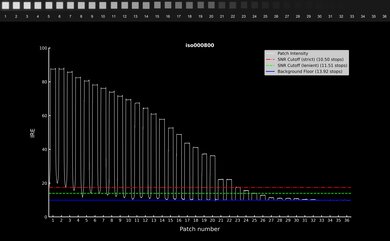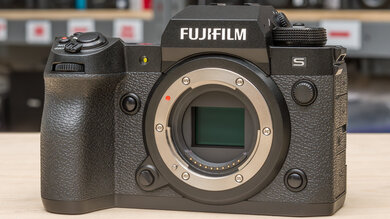- Table of Contents
- Intro
- Canon
- Sony
- Nikon
- Fujifilm
- Panasonic
- OM SYSTEM / Olympus
- Recent Updates
- All Reviews
- Comments

With so many different camera brands offering a wide range of cameras, it can be hard to narrow down the best of the best. Besides, with camera technology as advanced as it is, it's hard to go wrong with a good camera from any brand. The upshot is that choosing one over another mostly depends on personal preferences and needs, as well as what kind of lenses you want to use. Still, each brand has its own strengths and quirks, so it's good to be aware of what they each bring to the table.
We've bought and tested over 110 cameras from the best camera brands out there, and below are our top camera recommendations from the most popular brands. The brands aren't ordered by rank or position; the first brand listed isn't necessarily the best, and the last brand isn't the worst because what's best for you will depend on your own specific needs. Instead, we've listed the brands by popularity and market share while trying to keep brands with similar audiences together to make it easier to find what best suits your needs. If you're looking for your first camera, you can check out our recommendations for the best cameras for beginners. Otherwise, you can look at our picks for the best cameras for photography or the best cameras overall.
-
Canon
Travel Photography7.9Landscape Photography8.2Sport & Wildlife Photography8.3Vlogging7.7Studio Video9.0Action Video5.8Performance Usages: Raw Photo8.6Canon has been making cameras since the 1930s—often pitted against its long-time rival Nikon—and still largely dominates today's camera market. With exceptional professional services, Canon has long been a favorite among professional photographers, and their cameras typically feature accessible controls and intuitive menu systems, with a wide range of models to suit photographers of all experience levels. Whether it's beginner models like the Canon EOS R50 or more niche mid-range cameras like the wildlife-oriented Canon EOS R7, there's something here for everyone.
The best Canon camera we've tested is the Canon EOS R6 Mark II. Improving upon the already excellent Canon EOS R6, this enthusiast model can do it all. Its image quality is fantastic, and this camera performs incredibly well in low light. It also has an excellent autofocus system, borrowed from the pro-level Canon EOS R3, which can reliably track moving subjects, along with burst shooting at up to 40 fps in its electronic shutter mode. All in all, it's a very well-rounded hybrid camera for enthusiasts.
-
Sony
Travel Photography7.7Landscape Photography8.4Sport & Wildlife Photography8.3Vlogging7.8Studio Video9.3Action Video5.8Performance Usages: Raw Photo8.5Widely known for its TVs, soundbars, and headphones, Sony has also been making cameras since the 1990s, quickly growing into one of the best camera brands in the world. It's also one of the world's largest manufacturers of image sensors—in fact, you're likely to find Sony-built sensors inside cameras from other brands on this list. Sony cameras tend to have snappy, highly effective autofocus systems and relatively portable bodies. Since they've been making mirrorless cameras for longer than most brands, Sony's E lens mount also has a well-established lens ecosystem with plenty of excellent third-party options.
The Sony α7 IV is the best Sony camera we've tested. This hybrid model improves upon the highly popular Sony α7 III by updating its video specs to meet the demands of today's hybrid photo and video shooters. It also has a higher-resolution sensor, making it an excellent choice for high-level portraits and landscapes. With in-body image stabilization (IBIS), 10-bit 4:2:2 internal recording, excellent autofocus, and many lens options, this is one of the best enthusiast cameras you can get.
-
Nikon
Travel Photography7.9Landscape Photography8.3Sport & Wildlife Photography8.8Vlogging7.5Studio Video9.1Action Video6.8Performance Usages: Raw Photo8.5Nikon is another camera brand with a long history of producing optical devices, cameras, and lenses. One of the pioneering manufacturers of digital cameras throughout the 1990s, Nikon continues to hold its own among the top camera brands. Though it was slow to get on board the mirrorless train, Nikon has proven adaptable and continues to expand its lineup of mirrorless cameras and lenses, and its premium 'S Line' of lenses offers some of the highest-quality glass on the market. As in its heyday, the brand is known for pushing boundaries—from being the first brand to completely ditch a mechanical shutter with the Nikon Z 9 to making the longest fixed zoom lens on the market with the Nikon COOLPIX P1000.
If you're interested in Nikon, the Nikon Z 6III is the best Nikon camera we've tested. It's one of the only cameras at its price point to offer internal RAW video recording, in addition to the usual reliable build quality and excellent ergonomics that Nikon is known for. Plus, it has a partially stacked sensor that allows for quick burst shooting with minimal rolling shutter distortion, excellent IBIS, and a high-res viewfinder. The vintage-styled Nikon Z f is another great full-frame choice for those who prefer a retro look and want to save a bit of money, though its ergonomics can take some getting used to, and its video features aren't quite as advanced as the Z 6III.
-
Fujifilm
Travel Photography8.0Landscape Photography8.0Sport & Wildlife Photography8.5Vlogging7.2Studio Video8.7Action Video6.8Performance Usages: Raw Photo7.8As its name suggests, Fujifilm started as a photographic film manufacturer in the early twentieth century until it eventually began producing cameras in the late 1940s under the 'Fujica' moniker. It was also one of the most successful camera companies to transition from film to digital and is now one of the leading producers of APS-C and medium format mirrorless cameras. Fujifilm is unique in that it has stayed out of the full-frame market, giving the APS-C format its due. What unites most of the brand's models is an old-school and fun approach to design, with retro styling and physical control dials, as well as highly regarded JPEG colors and in-camera processing.
The Fujifilm X-H2S is one of the brand's two flagship APS-C models, along with the Fujifilm X-H2. These are among the best Fujifilm cameras we've tested, with performance that, in some ways, rivals full-frame competitors. The X-H2S is built around a 26 MP stacked-design sensor with a very fast readout speed for quicker burst shooting and fewer rolling shutter artifacts. The X-H2, meanwhile, uses an incredibly high-resolution 40.2 MP sensor. Both are hybrid beasts with advanced video capabilities and excellent IBIS systems. If you're looking for portability and the dedicated exposure dials that Fuji is known for, look to X-T series cameras like the Fujifilm X-T5, which shares the same high-res sensor as the X-H2 but in a more portable body.
-
Panasonic
Travel Photography8.0Landscape Photography8.7Sport & Wildlife Photography7.7Vlogging7.6Studio Video9.3Action Video5.6Performance Usages: Raw Photo8.9Panasonic makes everything from TVs, appliances, and projectors to professional and consumer cameras under the LUMIX brand name. For a long time, Panasonic mainly produced cameras within the Micro Four Thirds (MFT) system, which the company standardized in collaboration with Olympus. More recently, Panasonic has branched out into producing full-frame cameras thanks to its L-mount Alliance with Leica and Sigma, which all produce L-mount compatible cameras. Panasonic is also a market leader in bringing more advanced video features to consumer models.
The Panasonic LUMIX S5 II is the best Panasonic camera we've tested. While the original Panasonic LUMIX S5 offers a ton of value for its price, the S5 II improves upon the formula in a few key ways, namely being the first LUMIX camera to feature phase-detection autofocus. This enthusiast model is a great choice for hybrid and video shooters, with advanced video features like 6k video, internal 10-bit 4:2:2 recording, and plenty of codec/format support. It's no slouch for still photography, either, especially when it comes to image quality, though you'll want to look at MFT options like the flagship Panasonic LUMIX G9 II for a more established and compact lens lineup. Consider the Panasonic LUMIX GH7 for even more advanced video needs, with features like internal RAW recording and active cooling.
-
OM SYSTEM / Olympus
Travel Photography7.9Landscape Photography7.7Sport & Wildlife Photography7.5Vlogging7.7Studio Video8.5Action Video7.0Performance Usages: Raw Photo7.5OM SYSTEM, formerly known as Olympus, has been around in some form or another since the 1930s. Olympus was a major player in the days of film, achieving worldwide popularity in the 1970s and 1980s with its innovative 'OM System' line of SLRs. In the digital age, Olympus helped develop the Micro Four Thirds system in collaboration with Panasonic, offering a smaller, more affordable alternative to full-frame and APS-C cameras. These are the quintessential travel and hiking cameras, with rugged portable bodies, great stabilization, and computational photography modes. In 2021, OM Digital Solutions acquired Olympus's imaging division and began releasing cameras under the name OM SYSTEM in a callback to the company's heyday.
The OM SYSTEM OM-1 Mark II is the brand's flagship model and one of the best Micro Four Thirds cameras we've tested. It's the ultimate sports and wildlife camera for those who want something rugged and portable. It has a weather-sealed body with fantastic ergonomics and best-in-class image stabilization. On top of that, it has a remarkably fast max burst rate and plenty of neat computational photography features, including a high-resolution composite mode. All in all, it's a very well-rounded camera for fans of the Micro Four Thirds system.
Recent Updates
-
We added a comparison to the Panasonic LUMIX GH7 in the Panasonic section.
-
Sep 10, 2024 : We replaced the Nikon Z 6II with the Nikon Z 6III as the representative Nikon pick since it's a newer, more well-rounded model. We also added a brief mention of the Panasonic LUMIX G9 II in the Panasonic section.
-
Jun 13, 2024 : We replaced the OM SYSTEM OM-1 with the OM SYSTEM OM-1 Mark II.
-
Apr 15, 2024 : As we've only tested one PENTAX camera, and it's a more niche brand, we've removed the PENTAX K-3 Mark III from the list.
-
Feb 16, 2024 : Altered text throughout for concision and simplicity.
All Reviews
Our recommendations above are what we think are currently the best cameras for most people to buy from the best camera brands. We factor in the price, feedback from our visitors, and availability.
If you would like to choose for yourself, here's the list of all of our camera reviews. Be careful not to get too caught up in the details. While no camera is perfect for every use, most offer enough to suit most people's needs. Personal taste, preference, and shooting habits will matter more in your selection.
Comments
Best Camera Brands: Main Discussion
What do you think of our picks? Let us know below.
Looking for a personalized buying recommendation from the RTINGS.com experts? Insiders have direct access to buying advice on our insider forum.
Update: Removed the Dell U2723QE because it went up in price, and renamed the Dell S2722QC as ‘Best 4k Monitor For Work’; replaced the LG 32GP850-B with the Dell Alienware AW2724DM because it’s better for gaming; replaced the Gigabyte M34WQ with the Dell S3422DWG because the Gigabyte is hard to find; updated Notable Mentions based on changes.
What do you think of these changes? Let us know






































































